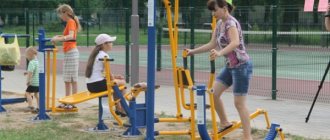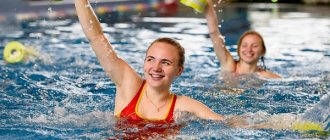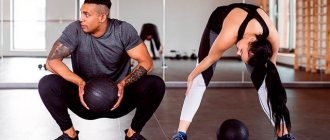How long does the recovery period after childbirth last?
The body's return to its natural state begins during childbirth. The apex of the sacrum deviates, pronounced vertebral curves are smoothed out. Over the next 6-8 weeks, this process is completed: intense contractions of the uterus help normalize its size, the pelvis closes, and menstruation resumes.
To stay in shape, many young mothers tend to go to the gym as soon as possible. But intense training in the postpartum period can be harmful to health; preference should be given to exercise therapy and visiting an osteopath.
Possible complications
Complications in women's health after a cesarean section occur much more often than after a normal birth. An organism in which significant changes occurred during the period of fetal growth is a priori weakened. A new negative factor in the form of an operation causes additional damage to him, leading to certain disorders. Complications can be caused by:
- Antibacterial therapy;
- Low quality material used for seams;
- Professionalism of the obstetrician;
- Technique and timing of the operation.
Based on them, complications can be expressed in the divergence of sutures, diseases of internal organs, and the consequences of prolonged exposure to anesthesia. The body's reaction is difficult to predict, and if it is negative, doctors have to prescribe additional treatment to the patient. There is no talk about physical activity in these cases.
It is obvious that the implementation of therapeutic complexes after a caesarean section provides the necessary support to the female body, allows you to quickly return the body to good shape and maintain health. Physical exercises, swimming in the pool, training various muscles also contribute to mental health. Returning to a comfortable size, feeling the elasticity of the muscles and enjoying a toned stomach, a woman feels doubly happy after becoming a mother.
When can you start exercising after giving birth?
The ideal option would be to resume classes 3-4 months after giving birth. But this does not mean that a woman can return to full-fledged training in her favorite fitness center.
First, she will need to visit a physical therapy doctor. Physical therapy is indicated not only during pregnancy, but also during the rehabilitation period after childbirth. Unlike a gym trainer, a physical therapy doctor understands the anatomy of the female body and knows its capabilities and limits after childbirth.
Therapeutic physical culture allows you to start the processes of restoring the biomechanics of the body. The return to usual training should be gradual, always under the supervision of a specialist. During the postpartum period, group training is not suitable, since recovery occurs very individually. During this period, it is advisable to regularly visit an osteopath for preventive purposes. This specialist will check the condition of the muscles, bones, ligaments, give direction for further training, and relieve pain.
Reasons for weight gain after surgery
Exercising after a cesarean section is necessary for faster weight loss. During surgical intervention, disruptions in the functioning of various systems occur. Weight accumulates and remains at this level for a long time for reasons such as:
- hormonal disbalance;
- restriction of physical activity;
- poor nutrition.
During natural childbirth, a rapid restructuring of the hormonal system occurs. During pregnancy, progesterone becomes the main hormone in the female body. This hormone maintains the viability and nutrition of the fetus. The approach of labor is accompanied by a decrease in progesterone levels. There is an activation of oxytocin. It helps the walls of the uterus push the baby into the pelvis. After the baby is born, oxytocin remains at the same level. Its further activity is associated with the rapid return of the uterus to its normal shape. Against this background, the disappearance of the postpartum pocket, which forms in the place of the abdomen, is observed. The pocket is gradually pulled up to the muscular frame of the peritoneum. The weight begins to return to normal.
A caesarean section does not allow the body to begin prenatal preparations. The date of surgery is set at the discretion of the doctor. It often occurs at the end of 37–38 weeks. The body's own oxytocin does not appear. This leads to a lack of natural contractile activity. The uterus retains stretched walls for a long time. Due to this, patients retain their abdomen after surgery. The situation is aggravated by the late appearance of milk.
Breastfeeding depends on the presence of prolactin in the bloodstream. Prolactin is formed under the influence of oxytocin. Late onset of lactation affects the long-term absence of uterine contractions, since breastfeeding helps enhance this process. After cesarean breast milk may appear only after 2 weeks.
The ban on physical activity also has a negative impact. After a normal birth, a woman can return to her previous lifestyle in 3-4 weeks. A caesarean section does not allow the patient to recover quickly. The restriction occurs due to the presence of a suture on the uterine wall. Any incorrect movement leads to the development of complications from the wound. For this reason, a woman cannot begin her usual life activities. She needs time for the stitches to heal.
The peculiarities of postpartum nutrition should also be taken into account. The child receives all the necessary microelements with milk. To ensure rich milk, you need to eat right. Enrichment is facilitated by eating a variety of foods. If you exclude fats from the diet, your child will not gain weight. This will negatively affect his health. Due to this feature, a nursing woman’s diet should be varied. This diet does not allow the patient to lose weight quickly.
What is the importance of postpartum recovery?
The pelvis is the support for the spine. The pelvic region contains muscles, bones and ligaments that protect the reproductive system, bladder and intestines. And, of course, all these organs require a complete blood supply. Pregnancy dictates its own rules, and a restructuring of the woman’s entire body, including the pelvis, occurs. Certain muscle groups are forced to be in constant tension, which entails rigidity in other groups. Possible compression of the nerves and the occurrence of pain. An osteopathic doctor can help you get rid of unpleasant sensations.
How can sports be dangerous after childbirth?
Most women who have given birth do not pay attention to warnings that training can be dangerous, but in vain. They can be dangerous due to the following complications:
- uterine bleeding;
- decreased lactation;
- prolapse of internal organs.
Let's analyze each situation.
The likelihood of uterine bleeding
Bleeding from the uterine cavity is the most dangerous complication. This is why you should not start physical activity, including squats and abdominal crunches, immediately after delivery. Physical activity increases pressure in the pelvic area, causes involuntary urination and increases the tension of sutures (if they were applied). As a result, bloody discharge from the birth canal intensifies and can develop into bleeding, which cannot be stopped without medical intervention. Uterine bleeding can worsen the health of a woman in labor, even leading to death.
To correct the abdomen, standard abdominal exercises are suitable. For greater efficiency, they can be performed with weights, holding dumbbells in your hands.
Exercising can affect milk production
Yes, as already noted, training affects lactation. It decreases under the influence of a hormone such as adrenaline, which is actively produced not only under stress, but also under increased stress. As a result, milk production decreases. This can be avoided by applying frequent breastfeeding and reducing the intensity of the load.
Playing sports is fraught with prolapse of internal organs
Another serious complication that early and intense training can cause is organ prolapse. During the period of bearing a child, a woman’s organs shift due to the fact that the baby grows and the uterus enlarges. After childbirth, the uterus gradually contracts and the organs, accordingly, also do not return to “their place” immediately. However, the muscles of the abdominal wall and uterus, which support the internal organs during pregnancy, are not able to support them after childbirth. As a result, during intensive exercise, their displacement may occur.
Thus, a relatively complete recovery of the female body after childbirth occurs only after one to two months. During this time, the uterus returns to its previous size, wounds heal, vessel walls are restored, and muscles and ligaments are strengthened. And only after all this happens can you begin to exercise.
Scar after cesarean section
To extract a baby during a cesarean section, it is necessary to make an incision through all layers of the anterior abdominal wall and the lower third of the uterus. Like any surgical intervention, this does not go away without leaving a trace. Therefore, it is important to recover properly, visit exercise therapy and an osteopath.
Caesarean section is one of the main causes of scarring on the uterus. Scar tissue is connective tissue that forms at the site of injury during the regeneration process. In itself, it does not pose a danger to a woman: the scar does not have a significant impact on a woman’s life. But this happens only until the woman thinks about giving birth again. A uterine scar is a complication associated with a cesarean procedure for a subsequent pregnancy. Connective tissue does not have one of the important properties of muscle - extensibility. Therefore, during pregnancy and labor, the uterus can be severely injured and ruptured along the scar line.
Effect of scar on body biomechanics
The body of each person is a single mechanism, where damage to one organ or tissue will entail consequences for others. This also applies to the scars that remain in a woman after a cesarean section. People who have large scars often turn to specialists with the following complaints: back and joint pain; · headache; · a feeling of discomfort of unclear localization. Scar tissue is a dense framework. It is capable of replacing other lost tissues, but is not able to replace their functions. The scar forms tension, which “pulls” other tissues onto itself, changing the vector of tension in the body. In turn, stress vectors affect not only muscles and organs, but can also adversely affect bone structures. A transverse scar can cause impaired mobility of the pelvic bones. Because of it, the lower extremities do not receive sufficient blood supply and constantly suffer from hypoxia. Another unpleasant consequence of a scar is the weakening of the pelvic floor muscles.
Osteopathy cannot heal a scar, but it can make it softer and more pliable. Due to this, tension will decrease and discomfort will subside. Thus, the osteopathic doctor does not muffle the symptoms, but purposefully acts on the causes of pain and discomfort. The sooner a woman begins to recover after a cesarean section, the fewer unpleasant consequences she will expect in the future.
Exercising after cesarean section: first steps
If a mother is interested in when she can play sports after a cesarean section, gynecologists begin to confidently broadcast a complete ban for 2 months, and sometimes for six months. You should not take their words literally, since they specifically mean sports, forgetting about moderate exercise, which will be completely safe for a woman.
Immediately upon returning from the maternity hospital, you can begin to restore your figure using the following methods:
- Keep your posture. The simplest method that is constantly forgotten. A straight back, straightened shoulders and a tucked in stomach are a very weak, but constant load on the corresponding muscle groups. In addition, correct posture changes the visual perception of your figure for the better.
- Hydromassage. If you have a shower head with a massage mode, take advantage of this opportunity - sharp jets of water perfectly tone muscles and skin. Just avoid the post-operative scar area until complete healing.
photo from the site forum.auto.ru
- Kegel exercises. Gentle loading on the pelvic floor muscles accelerates the contraction of the uterus and is a prevention of such troubles as prolapse of the vaginal walls. The point of the exercises is to rhythmically tense the perineum. You should alternate short, frequent tensions with rare but long ones (up to 20-30 seconds).
- Breathing exercises. You can only perform retraction and relaxation of the anterior abdominal wall, holding the suture area with your palm. Some of the exercises that involve protruding the abdomen are best postponed until the eighth or ninth week after childbirth.
photo from the site mon-charme.ru
The listed options are gentle sports after a caesarean section, when you can start which there are no medical restrictions. If you have the desire and time for exercise, proceed to it without fear, this will gently prepare your body for more thorough loads.
Features of children born by caesarean section
Children born naturally and by caesarean section are practically no different. There are many myths about “Caesareans”: · hyperactivity; · retardation in physical development; · mental retardation, etc. They do not have a scientific evidence base and should not cause concern to the mother. Complications with cesarean sections do occur, but are quite rare. These include: · disturbances in the functioning of the respiratory system; · dislocation of the cervical vertebrae; · increased nervous excitability; · change in muscle tone (can either increase or decrease). To correct these conditions, it is not necessary to resort to drug therapy. Most of them can be corrected with the help of exercises; in rare cases, it is permissible to use dietary supplements approved by a doctor.
Breathing exercises after cesarean section
Well, breathing exercises after a caesarean section will help speed up recovery. In most consultations, they are given in the form of a printout, but if you didn’t receive them, these are 10 deep breaths with the chest, without moving the stomach, 10 deep breaths with the stomach, holding the suture with your hands, and 10 gentle pull-ups of the stomach and perineal muscles inward.
Remember that any activity should be feasible, and you can return to setting records when the baby starts walking. By the way, running after him is additional cardio. These are not languid walks with a stroller.
Elena Selivanova, fitness trainer
source: www.mybodyflex.ru Beauty and HealthFitness and sports
Physical exercises after natural childbirth are allowed almost the next day if the woman feels well and the birth process went without any complications. Unfortunately, nowadays normal childbirth is becoming a rarity, and many women know what birth injuries, ruptures and surgical incisions of the perineum are. However, sutures after such injuries and operations heal relatively quickly - in about 2-2.5 months, and then you can exercise more and more actively.
But when is sports allowed after a caesarean section?
Osteopathic work with the “child-mother” pair
Childbirth is a process where both mother and baby are exposed to heavy stress. Therefore, it is important to competently create an exercise program for both participants in this difficult process.
A child undergoes a serious test during labor, not only in the case of a cesarean section. Often, to stimulate labor naturally, forceps, vacuum technologies, and “squeezing” techniques are used. In such circumstances, the baby's skull is subjected to heavy stress, and there is a risk of damage to the cranial nerves. In addition to the skull, the spine and pelvic bones can be traumatized. Without appropriate exercises, these conditions will lead to impaired growth and development, and curvature of the spine. In the future, such a child will suffer from joint problems and constant back pain.
Children who were born by cesarean section especially need the supervision of an osteopathic doctor. They did not receive natural stress and natural modeling, like children during natural childbirth. In this situation, the formation of the most important ossification points of the cranium becomes difficult.
The body of a new mother is also under stress. During pregnancy, a significant expansion of the pelvic bones occurs, and the elasticity of the ligaments increases. All this is necessary for childbirth to proceed easily. But, as practice shows, it is difficult for a woman’s body to return to the state it had before pregnancy on its own. The woman’s pelvic bones should narrow and the ligaments should stabilize. But if this process is not controlled, the bones can deviate from their natural axis by several millimeters. At first glance it may seem that this is quite insignificant. But meanwhile, women who have had a shift in the pelvic bones suffer from chronic pain in the lower abdomen, and over time, deformation of the organs is discovered.
Childbirth is only part of the stress a woman experiences when a baby is born. Caring for a child also puts additional stress on the female body: a forced position while bathing the child, putting him in a crib, constant stress on the spine and pelvis when rocking him to sleep.
Many women suffer from depression during the postpartum period. Changes in hormonal levels, lack of sleep, constant muscle tension - all this negatively affects the mother’s condition. Regular exercises with an osteopath after childbirth will help you avoid even such consequences.
That is why it is important to understand: visiting an osteopathic doctor will help mother and child lead a healthy and fulfilling life. Both organisms go through great stress, so rehabilitation is given special importance. At an early age, there is an inextricable connection between a mother and her baby; they very sensitively feel each other’s moods and pains. It is recommended to visit an osteopath immediately after discharge from the maternity ward, especially after a caesarean section. He will examine the mother and child and prescribe the necessary exercises for both of them.
Types of exercises
Today there are a large number of different complexes. Training allows you to increase the load on different muscle groups. After a caesarean section there are a number of contraindications to training. Thanks to them, light loads are allowed, eliminating the work of the press. Women who have undergone surgery should resort to the following complexes:
- Pilates;
- water aerobics;
- asanas for nursing mothers.
Pilates allows you to make smooth movements that help stretch muscles and improve skin tone. This training avoids stress on the muscles and the seam. Also, the press remains inactive. Pilates is used by nursing mothers to tighten the pocket.
Water aerobics has a good effect. The visit should begin from the moment the menstrual cycle begins. The load on the muscular frame in water remains invisible to a woman.
At the same time, the exercises are intense. Water aerobics helps quickly eliminate fat deposits and helps strengthen the muscle frame. This kind of fitness is allowed for women with various bone tissue pathologies. Aerobics in water also has a positive effect on women whose weight is much higher than normal.
Modern patients are increasingly beginning to resort to performing asanas. Yoga is an ideal way for a woman to recover after a caesarean section. This kind of sports has a positive effect on your figure and psycho-emotional state. Yoga normalizes the production of endorphin - the hormone of happiness. It also eliminates severe muscle tension. They gradually stretch. The skin of the abdominal region is pulled towards the abs. The belly becomes less noticeable.
The first workout should not last more than 20 minutes. You should pay attention to the body's reaction. The reaction may vary. In the first days of playing sports, various processes can be observed.
Due to prolonged lack of physical activity, muscles gradually become flabby. The first workouts cause a surge of lactic acid. It is formed in the muscles due to a chemical reaction. This phenomenon is accompanied by pain and discomfort in the limbs. A gradual increase in load reduces the intensity of acid formation. The pain disappears.
The time spent playing sports should not be increased immediately. You can add 5-10 minutes with each workout. A typical workout should be one hour long. This duration will allow the woman to properly distribute time. The number of workouts should be 3 times a week. More frequent visits to the gym can harm lactation.
Osteopath after childbirth: in what cases is it necessary to contact?
A visit to an osteopath after childbirth is not a mandatory procedure, but rather a recommendation. However, it is worth knowing about the symptoms when seeing a doctor is necessary: · Pain in the tailbone or sacroiliac joint. Their appearance provokes sprains during the passage of the child through the birth canal. The large weight of the fetus can aggravate the situation. · Pain in the pubic symphysis. Another consequence of sprained ligaments during childbirth. The pain is acute, entails a change in the biomechanics of the whole body, a constant forced position leads to weakening of the abdominal muscles. · Back pain. If a child is a frequent guest in the mother’s arms, then the spine and pelvis will painfully respond to the heaviness. · Headaches, pain in the cervical spine. They arise as a result of incorrect posture when breastfeeding the baby, as well as incorrect posture during sleep. · Change in the position of the sacrum. Organs receiving innervation from the sacral plexus suffer from discomfort. And due to disturbances in muscle function, pinching of the sciatic nerve is possible.
The baby should definitely be shown to an osteopathic doctor if there was a difficult birth. Also reasons to come for a consultation are the presence of any asymmetry, frequent colic and regurgitation, hip dysplasia.
How to do a plank after childbirth?
It is worth considering that in addition to restoring the body immediately after childbirth, you cannot do a plank, especially a dynamic one, when a girl has:
- any diseases of the musculoskeletal system (without prior consultation with a neurologist, vertebroneurologist or orthopedist);
- disruptions in the functioning of the heart, and even more so diseases of the cardiovascular system;
- hernia in any part of the body;
- pinched nerve roots.
If there are no these abnormalities in the body and a sufficient period of time has passed since childbirth, then you can start training.
It can be done both direct and reverse. Moreover, it is better to combine or alternate them. As for the number of approaches, it all depends on individual capabilities. If unpleasant sensations arise during the load, then you should simply reduce the time you spend standing in the plank or reduce the number of approaches.
It is important to understand that the correct technique will give good results faster than the other way around.
Exercise tones muscles, tightens and increases their strength, strengthens ligaments and tendons, and also creates a good base for other exercises.
Summing up
Pregnancy and childbirth are a serious test for the female body. Nowadays it is rare to meet a person who does not have any chronic diseases. And during this stressful period for a woman, all of them can become aggravated, cause additional discomfort, and bring anxiety.
To be sure of a favorable course of pregnancy and rehabilitation after childbirth, it is important to visit an osteopath for prevention.
In cases where the pregnancy was difficult, there was a caesarean section - a visit to an osteopath should be a mandatory procedure after discharge from the maternity hospital. This will help mother and baby recover faster and begin to live in harmony with their body.
A visit to an osteopathic doctor for a woman is the key to her reproductive health. After all, scars can become a serious complication during the next pregnancy.
An osteopath will help a woman return her organs to the desired position. The exercises performed restore muscle tone, and proper distribution of tension in the body occurs. Scars and scars become more pliable and elastic. There is relief from pain and discomfort. A woman’s life returns to normal faster, and her health improves.
Similar articles:
- Directions
- Specialists
- For visitors
- Articles and videos
“Healthy Summer” 1000 rubles discount on an appointment with osteopathic doctor E.A. Ukhmylin.
Adult admission 6 thousand, children admission 5 thousand.
When can you start pumping up your abs?
For some women, doctors recommend starting to pump up their abs while still in the maternity hospital to quickly restore their figure. However, this is wrong. As in the case of squats, the press should be started only after the body has fully recovered after childbirth.
First of all, it is important to understand that depending on the type of birth, the timing of introducing certain exercises into the life of a new mother will differ.
Caesarean section is considered a complicated delivery and is performed when a woman, for one reason or another, cannot give birth on her own. Recovery after surgery takes longer and, accordingly, abdominal exercises for women after surgery are contraindicated for a long time. It is recommended that at least 10 months pass, and at best a year. Otherwise, serious complications may occur.
After a natural birth without tearing or episiotomy
After spontaneous childbirth, a woman has more opportunities to return to her previous shape quickly. Especially if they passed without ruptures or episiotomy. In this case, the uterus recovers faster, especially if the woman is breastfeeding.
After a natural birth, it is recommended that during the first month you completely avoid any exercises that put stress on the abdominal muscles.
You can start pumping up your abs only after a month, or when the postpartum discharge ends. It is important to start classes gradually. Intense loads will only cause harm and can lead to serious consequences.











